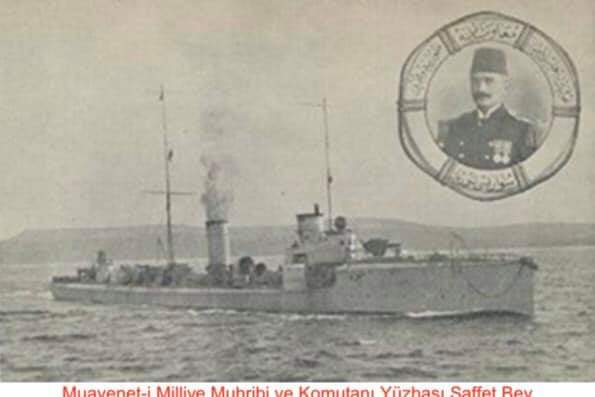Muavenet-i Milliye or Muâvenet-i Millîye was a destroyer built for the Ottoman Navy prior to World War I. The ship is most notable for sinking the British pre-dreadnought battleship Goliath during the Dardanelles Campaign in World War I.
"Muâvenet" means support in Ottoman Turkish, and the full name of this first ship of that name, "Muâvenet-i Millîye", signifies national support. Her name was given in honour of the Ottoman Navy National Support Association (Donanma-i Osmânî Muâvenet-i Millîye Cemiyeti, in short, Navy Association / Donanma Cemiyeti). This association was founded on the initiative of a merchant named Yağcızade Şefik Bey in July 1909, followed shortly afterwards by wider participation including the more modest layers of the society. It collected funds through voluntary participation from among the Ottoman public to finance her purchase. Muâvenet-i Millîye was the first ship purchased, in Germany, through the financing made available thanks to the efforts of the association.
Three other Turkish Navy ships of different periods, the last being presently in service, were later named in memory of Muâvenet-i Millîye to recall her achievement. One of the first aircraft of the Ottoman air squadrons, contemporaneous to the ship, was given the same name.
Muavenet-i Milliye and her sister ships, Yadigar-i Millet, Numune-i Hamiyet, and Gayret-i Vataniye, were originally laid down as the German torpedo boats S165-S168. Upon completion, they were sold to the Ottoman Navy in September 1910. (Schichau-Werft built the second group of torpedo boats named S165-S168 as replacements, completing them in 1911.)
As of 1912, the command of Muâvenet-i Millîye was assumed by the Kıdemli Yüzbaşı (senior lieutenant, see Naval officer ranks) Ayasofyali Ahmed Saffed (after the Surname Law of 1934: Ahmet Saffet Ohkay), member of a new generation of officers who were specially trained in view of the more modern ships the Ottoman Navy acquired. In the first months of the Ottoman entry into World War I, the ship was assigned to missions in the Black Sea, from where she was re-directed towards Çanakkale with the start of the Dardanelles Campaign.
The French had asked the assistance of the battleships against the Ottoman counterattacks targeting to recapture Kerevizdere. Thus, every night two battleships began to bombard the Ottoman positions. The Ottoman side, to eliminate damages caused by these battleships, assigned Muâvenet-i-Millîye. During the day, the German captain lieutenant Rudolph Firle[2][3] and two other officers, who had carried out a reconnaissance mission near Morto Bay earlier, had embarked on Muâvenet-i Millîye to manage the torpedo operations. An On 10 May, at 13:30, Muâvenet-i-Millîye arrived at the strait and the preparations for its new assignment had begun. It was on 12 May, at 18:40, Muâvenet-i-Millîye went into action. Between 19:00 and 19:30, she passed the mines and on 19:40 she anchored in Soğanlıdere and waited until midnight. The projectors of the Allied battleships were closed down at 23:30.
 |
| HMS Goliath |
 |
| Commander of the Muavenet-i Milliye, major Ahmed Saffet Bey |
The ship captain, Kıdemli Yüzbaşı Ayasofyali Ahmed Saffed, the German lieutenant Rudolph Firle and his two deputies and the over 90 Ottoman crew were greeted as heroes in Istanbul, all lights along the Bosphorus having been lit especially to their honour, and were rewarded with medals and decorations.
At the Battle of Imbros on 20 January 1918, Muavenet-i Milliye and three other Ottoman destroyers sortied from the Dardenelles and engaged the British destroyers Lizard and Tigress which were chasing the crippled Ottoman battlecruiser Yavûz Sultân Selîm. These were driven off, and Yavûz returned to Constantinople.[4]
With the collapse of the Ottoman war effort, Muavenet-i Milliye was decommissioned in October 1918. Discarded by the postwar Turkish Navy in 1924, the ship was used as an accommodation hulk at the Taşkızak shipyard. She was finally scrapped in 1953.



No comments:
Post a Comment